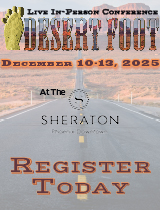|
|
|

|
Search
11/27/2019 Alan Sherman, DPM
The Rebalancing of Podiatric Medical and Surgical Residency Education
Chuck Ross started an interesting discussion
triggered by his attending the always excellent
Richard O. Schuster Memorial Seminar in
biomechanics last week. He makes the statement
that the concern regarding the lack of emphasis
on biomechanics should be focused on the 3 years
of residency education, where he notes that
there is a “dramatic lack of a continuum once
students graduate and enter residency programs,
with few exceptions as the emphasis is solely
upon surgery.”
Allen Jacobs shares his experiences with
speaking to residents, “that it is distinctly
uncommon to see gait analysis performed on most
patients, including those being evaluated for
surgical intervention” and “As an ABFAS
reviewer, I can tell you that a detailed
documented weight-bearing examination is
typically not present”.
Kevin Kirby adds, “I believe this is due to the
fact that their post-graduate training is
relatively deficient in regular and practical
training in these important subjects.
Ultimately, this lack of consistent training
makes them less knowledgeable and/or less
comfortable in applying these important
conservative treatment skills to their patients
once they enter their respective podiatric
practices.”
I couldn’t agree more. I believe that in our
zeal to train ALL podiatric residents to be
advanced foot and ankle surgeons, we are
neglecting a good deal of training in podiatric
medicine including biomechanics. While we have
made quite notable achievements in the last 30
years in our training of advanced foot and ankle
surgeons. But these observations by Ross,
Jacobs, and Kirby training show that the current
3 years PMSR model in podiatric residency
education is lacking certain essential elements
that advanced foot and surgeons should be
focused on, that being foot kinetics and
kinematics, what Jarrod Shapiro refers to as
Biotechnical Decision Making – the KK Approach
in Practice Perfect 667.
And that is not all that is being de-emphasized.
While all residency directors in all programs
are doing their best to deliver a balanced
residency training experience to their
residents, I believe that we have reached the
point where we are trying to do too much. You
can’t emphasize everything. The time and
attention of residents and their directors is
truly a zero sum game. In most programs, they
can’t do more than they are doing now.
When you take a broad regional area of the human
body like the lower extremity and try to cover
all the medical care that it needs, if you
emphasize advanced foot and ankle surgery, you
necessarily de-emphasize something else.
Biomechanics has become one of those things, but
think of all the rest of podiatric medical
practice that must be de-emphasized to allow for
the hard time and energy consuming focus on
advanced foot and ankle surgery.
2020 is going to be an important year for
podiatric residency education with CPME doing
their assessment of the CPME 320 document, the
STANDARDS AND REQUIREMENTS FOR APPROVAL OF
PODIATRIC MEDICINE AND SURGERY RESIDENCIES,
which is the document which defines and
regulates podiatric residency programs. It’s
essential that at this point in the history of
podiatry, we assess what we are currently
accomplishing with the PMSR 3-year residency
standard.
We need to understand what type of podiatrists
are coming out of these programs, what skills
they have, what skills they lack, and what
portion of the foot care needs of Americans they
are well trained to handle. Our residency
programs are badly overdue for a rebalancing.
My feeling is that podiatry is predominantly a
medical specialty and surgery is a part of it.
Podiatry is predominantly an office/clinic based
specialty and hospital work is a part of it.
We need to add much more office/clinic work to
our programs, because that is the best setting
in which to teach residents the continuity of
care of both surgical patients and podiatric
medical patients. In our effort to emphasize
hospital and outpatient surgery in our residency
training programs, we have de-emphasized what
podiatrists have always done most, as if it
doesn’t require its own intensive education.
Alan Sherman, DPM, Boca Raton, FL
There are no more messages in this thread.
|
| |

|
|







